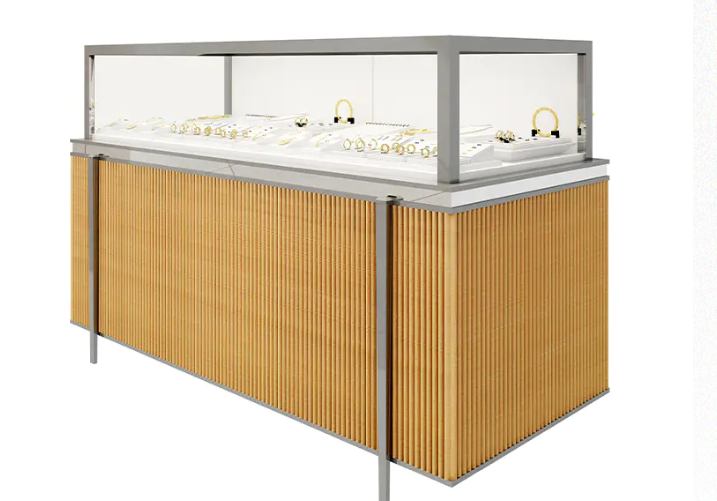Jewelry display cases are not only containers for dazzling treasures but also crucial tools for shaping brand image, attracting customers' attention, and ultimately driving sales. A well-designed jewelry display case should maximize the aesthetic value of the jewelry while creating a comfortable and memorable shopping experience for customers.
Lighting is the soul of jewelry display; its design determines whether jewelry can truly shine. Precise lighting not only highlights the material, color, and facets of jewelry, but also shapes the atmosphere and guides customers' attention.
Precise Matching of Color Temperature and Light Color: Jewelry of different materials requires lighting of varying color temperatures to enhance their unique beauty. Warm-toned precious metals such as gold and karat gold appear richer and more golden under warm white light of a lower color temperature (3000K-3200K), enhancing their luxurious and warm appearance. Cool-toned materials like platinum, silver, diamonds, and gemstones require cool white light with a high color temperature (above 6000K) to fully showcase their cool, crystal-clear brilliance and brilliance. LED lamps have become the preferred choice for jewelry lighting due to their energy efficiency, high efficiency, and excellent color reproduction.
Illumination and accent lighting: Jewelry stores need to highlight jewelry through strong contrasts of light and dark. Small jewelry pieces like diamonds and gold should use accent lighting with sufficient illumination, with a recommended ratio of 10:1 to 30:1 to ambient light, to create a focal point. Materials like jade and crystal, which emphasize translucency, require less illumination; instead, the quality of the light should be emphasized. Low-power, multiple light sources should be used to fully express their translucency and brilliance. Window lighting requires sufficient brightness, and adjustable recessed fixtures can be used for accent lighting. The wattage and color temperature of the lamps should be tailored to the jewelry type and the window height.
Light angle and anti-glare treatment: The direction of incident light is crucial. For jewelry that relies solely on reflected light, such as gold and pearls, the direction of the light should be carefully considered to ensure the reflected "sparkle" stimulates the customer's eye. For jewelry that emphasizes translucency, such as jade and crystal, the translucency should be emphasized.
Lighting Safety and Environmental Protection: Heat and UV rays generated by light can damage certain jewelry, such as jade. Therefore, choose LED lamps with low thermal resistance and good heat dissipation, and avoid placing the lamps too close. For jewelry that is sensitive to humidity, such as jade, place a small cup of water inside the display case to maintain a stable humidity level.
Jewelry display is far more than simple placement; it is a discipline that integrates visual art, consumer psychology, and spatial planning. Careful display can bring jewelry to life, tell a brand story, and inspire customers to purchase.
White Space and the Beauty of Proportion: Overcrowded displays can appear cheap and difficult to navigate. A widely followed golden rule is "30% free space, 70% display." This proportion not only reflects the customer's desire for a sense of hierarchy, but also creates a neat and tidy display, giving the jewelry room to breathe and highlighting its preciousness.
Design and Visual Guidance: Breaking away from the traditional matrix display format and cleverly utilizing the jewelry itself to create visual patterns can significantly enhance the display case's appeal. For example, a jewelry store experimented with bracelets arranged in "L" and "V" shapes, resulting in significantly higher bracelet sales than other counters that month. Adjacent display cases should also be coordinated; for example, if one displays items in a diamond pattern, another could try a horizontal display to create visual variation and enrich the spatial hierarchy.
Color Coordination and Harmony: Applying color psychology can effectively guide customer emotions. Using vibrant backgrounds or props (such as a colorful pallet or bust) can make specific jewelry pieces stand out and quickly draw attention. Grouping jewelry of the same color or material (e.g., all silver jewelry together) creates a unified look, creating a neat and cohesive atmosphere and making it easier for customers to browse and compare items.

The display case's design style must be highly consistent with the jewelry brand's positioning, target customer base, and the overall store aesthetic, creating a harmonious and unified overall image.
Modern Minimalist Style: Characterized by clean lines, pure tones (such as black, white, and gray), and highly transparent tempered glass with a metal frame, this style is suitable for fashion-conscious jewelry brands that specialize in diamonds, platinum, and other contemporary designs. This style emphasizes "less is more," allowing the jewelry itself to take center stage, highlighting its exquisite craftsmanship and fashionable design, making it a popular choice among young consumers.
Classic Elegant Style: Utilizing dark, high-quality woods (such as oak and walnut), intricate carvings, and warm lighting, it creates an elegant, warm, and historically artistic atmosphere. This style is ideal for displaying jewelry items that emphasize heritage, luxury, and classicism, such as gold, antique jewelry, and traditional jadeite, conveying the brand's profound heritage and noble character.
The trend toward personalized customization: Jewelry display counter design increasingly emphasizes customization and personalization. Each jewelry store should tailor its display cases to its unique characteristics and style. The use of sustainable materials, such as natural wood, recyclable glass, and metal, is becoming increasingly popular. These materials not only create a unique feel but also convey a brand's commitment to environmental protection and social responsibility, establishing an emotional connection with environmentally conscious consumers.